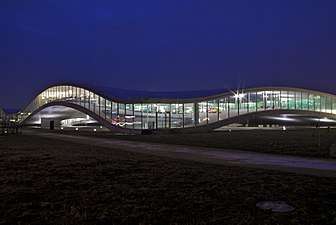Human Brain Project
| Human Brain Project | |
|---|---|
| Type of project | Scientific Research |
| Location | Europe |
| Owner | European Union |
| Founder | Henry Markram |
| Country | Switzerland |
| Established | 2013 |
| Website |
www |
The Human Brain Project (HBP) is a large ten-year scientific research project, based on exascale supercomputers, that aims to build a collaborative ICT-based scientific research infrastructure to allow researchers across Europe to advance knowledge in the fields of neuroscience, computing, and brain-related medicine.[1] The Project, which started on 1 October 2013, is a European Commission Future and Emerging Technologies Flagship. The HBP is coordinated by the École Polytechnique Fédérale de Lausanne and is largely funded by the European Union.[2] The project coordination office is in Geneva, Switzerland.[3]
Strategic goals and organisation

Fundamental to the HBP approach is to investigate the brain on different spatial and temporal scales (i.e. from the molecular to the large networks underlying higher cognitive processes, and from milliseconds to years). To achieve this goal, the HBP relies on the collaboration of scientists from diverse disciplines, including neuroscience, philosophy and computer science, to take advantage of the loop of experimental data, modelling theories and simulations. The idea is that empirical results are used to develop theories, which then foster modelling and simulations which result in predictions that are in turn verified by empirical results.[4]
The primary objective of the HBP is to create an ICT-based research infrastructure for brain research, cognitive neuroscience and brain-inspired computing, which can be used by researchers world-wide.
The Project is divided into 12 Subprojects. Six of these develop ICT-based platforms (Subprojects 5-10), which consist of prototype hardware, software, databases, and programming interfaces. These tools are available to researchers worldwide via the HBP Collaboratory. Three Subprojects gather data on empirical neuroscience and establish theoretical foundations (Subprojects 1-4) and one is responsible for ethics and society (Subproject 12). Subproject 11 coordinates the project.
- SP1 Mouse Brain Organisation: Understanding the structure of the mouse brain, and its electrical and chemical functions
- SP2 Human Brain Organisation: Understanding the structure of the human brain, and its electrical and chemical functions
- SP3 Systems and Cognitive Neuroscience: Understanding how the brain performs its systems-level and cognitive functional activities
- SP4 Theoretical Neuroscience: Deriving high-level mathematical models to synthesize conclusions from research data
- SP5 Neuroinformatics Platform: Gathering, organising and making available brain data
- SP6 Brain Simulation Platform: Developing data-driven reconstructions of brain tissue and simulation capabilities to explore these reconstructions
- SP7 High-performance Analytics and Computing Platform: Providing the ICT capability to map the brain in unprecedented detail, construct complex models, run large simulations, and analyse large volumes of data
- SP8 Medical Informatics Platform: Developing the infrastructure to share hospital and medical research data for the purpose of understanding disease clusters and their respective disease signatures
- SP9 Neuromorphic Computing Platform: Developing and applying brain-inspired computing technology
- SP10 Neurorobotics Platform: Developing virtual and real robots and environments for testing brain simulations
- SP11 Central Services: General coordination of the project
- SP12 Ethics and Society: Exploring the ethical and societal impact of HBP’s work
The HBP is coordinated by the École Polytechnique Fédérale de Lausanne, and scientific direction is provided by representatives from each of the HBP's Subprojects. The HBP involves researchers from over 117 partner institutions in 19 countries across Europe.[1] Notable Partner Institutions include the University of Heidelberg, Forschungszentrum Jülich, and the University Hospital of Lausanne.
Funding
The HBP is funded by the European Commission Directorate General for Communications Networks, Content and Technology (DG CONNECT) under the Horizon 2020 framework, an EU Research and Innovation funding programme. It was one of the two initial Future Emerging Technologies (FET) Flagship projects.
The project is split into five phases, each supplied with separate funding. The call for funding for the Project's initial two-and-a-half-year 'Ramp-Up Phase' of EUR 54 million closed in November 2013 and the results were announced in March 2014. Twenty-two projects from thirty-two organisations were selected for the initial funding of EUR 8.3 million.[5] The Ramp-Up Phase ended on 31 March 2016. Funding is reassessed every two years using Specific Grant Agreements (SGA); the first of which began in April 2016 (ending in April 2018). The HBP's total costs are estimated at EUR 1.019 billion, of which EUR 500 million will be provided by the European Commission, EUR 500 million by national, public and private organisations, and EUR 19 million by the Core Project Ramp-Up Phase Partners.[1]
Obstacles
One of the Project's primary hurdles is the unsystematic nature of the information collected from previous brain research. Neurological research data varies by biological organisation schemes, species studied, and by developmental stages, making it difficult to collectively use the data to replicate the brain in a model that acts as a single system.[6]
Other obstacles include engineering problems involving power consumption, memory, and storage.[7] For example, detailed neuron representations are very computationally expensive,[8] and whole brain simulation is at the leading edge of our computational capability.
Implications

Technologies generated by the HBP and other similar projects offer several possibilities to other fields of research. For instance, a brain model can be used to investigate signatures of disease in the brain and the impact of certain drugs, enabling the development of better diagnosis and treatment methods. Ultimately, these technologies will likely lead to more advanced medical options available to patients at a lower cost.[6]
In addition, detailed brain simulation requires significant computing power, leading to developments in supercomputing and energy-efficient, brain-inspired computing techniques. Computational developments can be extended into areas such as data mining, telecommunications, appliances, and other industrial uses.[6]
The long-term ethical consequences of the Project are also considered. The Project follows a policy of Responsible Research and Innovation, and its Ethics Advisory Board is responsible for monitoring the use of human volunteers, animal subjects, and the data collected. Implications on European society, industry, and economy are investigated by the HBP Ethics and Society Programme's Foresight Lab.[10]
Criticism
An open letter was sent on 7 July 2014 to the European Commission by 154 European researchers (750 signatures as of 3 September 2014)[11] complaining of the HBP's overly narrow approach, and threatening to boycott the Project.[12] Central to this controversy was an internal dispute about funding for cognitive scientists who study high level brain functions, such as thought and behaviour. However, the HBP stated that there is “no question that cognition and behaviour are vital to the HBP”, explaining that cognitive neuroscience research was repositioned in the Project to allow the Core Project to focus on building the Platforms. In addition, The Open Letter called on the EC to “reallocate the funding currently allocated to the HBP core and partnering projects to broad neuroscience-directed funding to meet the original goals of the HBP—understanding brain function and its effect on society”. In its response, the HBP said that “while [neuroscience research] generates a vast amount of valuable data, there is currently no technology for sharing, organising, analysing or integrating this information, beyond papers and even databases. The HBP will provide the critical missing layer to move towards a multi-level reconstruction and simulation of the brain”. It added that “cognitive and behavioural neuroscience will become the most significant component of neuroscience in HBP over the course of the Project. However, for this to happen the Platforms have to be in place first”.[13]
Peter Dayan, director of computational neuroscience at University College London, argued that the goal of a large-scale simulation of the brain is radically premature,[14] and Geoffrey Hinton said that "[t]he real problem with that project is they have no clue how to get a large system like that to learn".[15] Similar concerns as to the project's methodology were raised by Robert Epstein.[16]
The HBP has said that its members share the uncertainty surrounding large-scale simulation, but that “reconstructing and simulating the human brain is a vision, a target; the benefits will come from the technology needed to get there. That technology, developed by the HBP, will benefit all of neuroscience as well as related fields”.[13]
In 2015 the project underwent a review process and the three-member executive committee, led by Markram, was dissolved[17] and replaced by a 22-member governing board.[18]
See also
References
- 1 2 3 Human Brain Project, Framework Partnership Agreement https://www.humanbrainproject.eu/documents/10180/538356/FPA++Annex+1+Part+B/41c4da2e-0e69-4295-8e98-3484677d661f
- ↑ http://ec.europa.eu/programmes/horizon2020/en/h2020-section/fet-flagships
- ↑ "Human Brain Project relocates to Geneva". SwissInfo. 29 October 2013. Retrieved 29 October 2013.
- ↑ Amunts, Katrin; Ebell, Christoph; Muller, Jeff; Telefont, Martin; Knoll, Alois; Lippert, Thomas (2016). "The Human Brain Project: Creating a European Research Infrastructure to Decode the Human Brain". Neuron. 92 (3): 574–581. doi:10.1016/j.neuron.2016.10.046. PMID 27809997.
- ↑ "The Human Brain Project just got bigger". Retrieved 2014-07-07.
- 1 2 3 "A Report to the European Commission" The Human Brain Project.
- ↑ https://www.humanbrainproject.eu/discover/the-project/overview
- ↑ Forrest, Michael D (2015). "Simulation of alcohol action upon a detailed Purkinje neuron model and a simpler surrogate model that runs >400 times faster". BMC Neuroscience. 16. doi:10.1186/s12868-015-0162-6.
- ↑ "Human Brain Project relocates to Geneva - SWI swissinfo.ch". SWI swissinfo.ch. Retrieved 2016-03-11.
- ↑ Human Brain Project-Ethics and Society Archived 29 August 2013 at the Wayback Machine..
- ↑ Frégnac, Yves; Laurent, Gilles (2014). "Neuroscience: Where is the brain in the Human Brain Project?". Nature. 513 (7516): 27–9. Bibcode:2014Natur.513...27F. doi:10.1038/513027a. PMID 25186884.
- ↑ "Open message to the European Commission concerning the Human Brain Project". Retrieved 2014-07-07.
- 1 2 "The Vital Role of Neuroscience in the Human Brain Project" (PDF). Archived from the original (PDF) on 23 August 2014. Retrieved 11 March 2016.
- ↑ "Scientists threaten to boycott €1.2bn Human Brain Project". The Guardian. 7 July 2014. Retrieved 2014-07-07.
- ↑ Brean, Joseph (2014-07-08). "A billion-dollar European effort to model the brain in a supercomputer is in danger of collapsing". National Post.
- ↑ "Your brain does not process information and it is not a computer – Robert Epstein | Aeon Essays". Aeon. Retrieved 2016-05-23.
- ↑ Theil, Stefan (2015). "Trouble in Mind". Scientific American. 313 (4): 36–42. Bibcode:2015SciAm.313d..36T. doi:10.1038/scientificamerican1015-36.
- ↑ http://sciencebusiness.net/news/77294/%E2%82%AC1B-Human-Brain-Project-back-on-track-after-Commission-signs-new-contract%5Bfull+citation+needed%5D